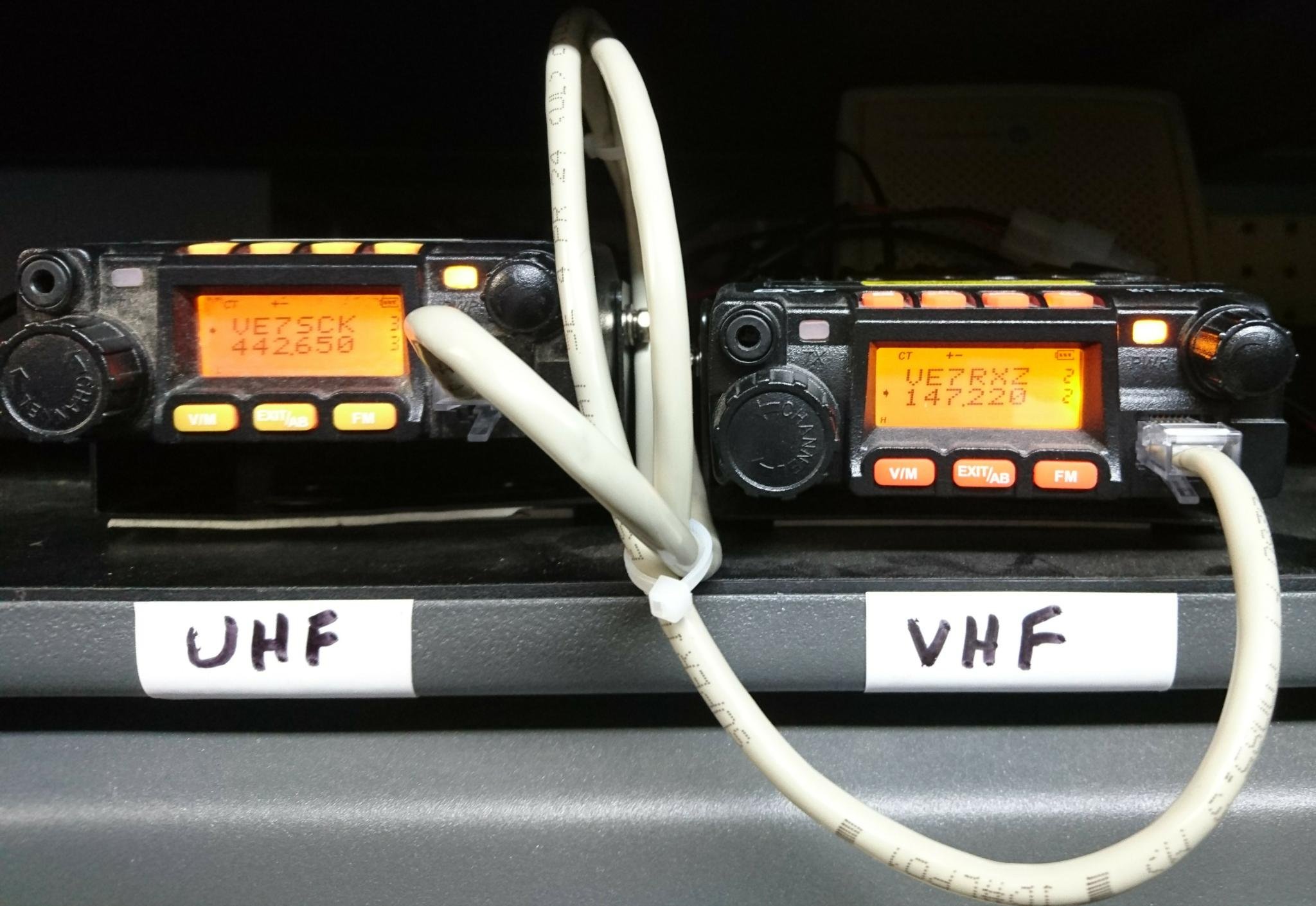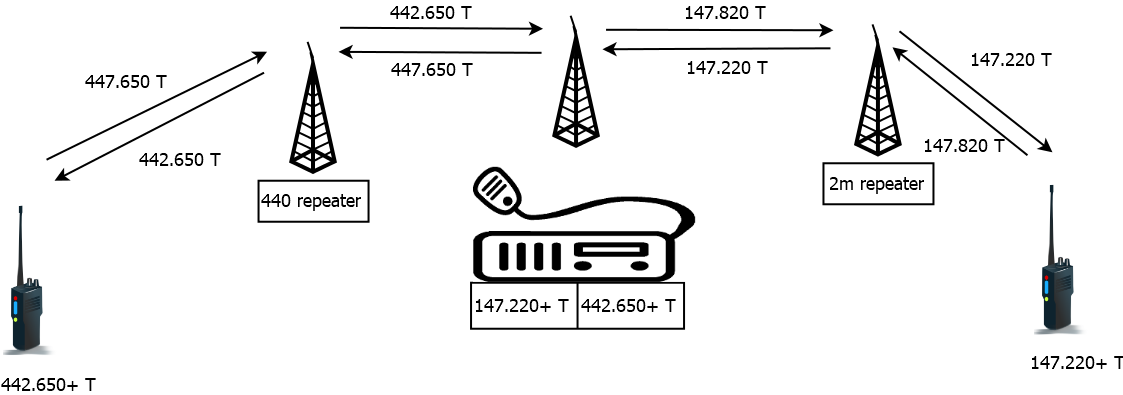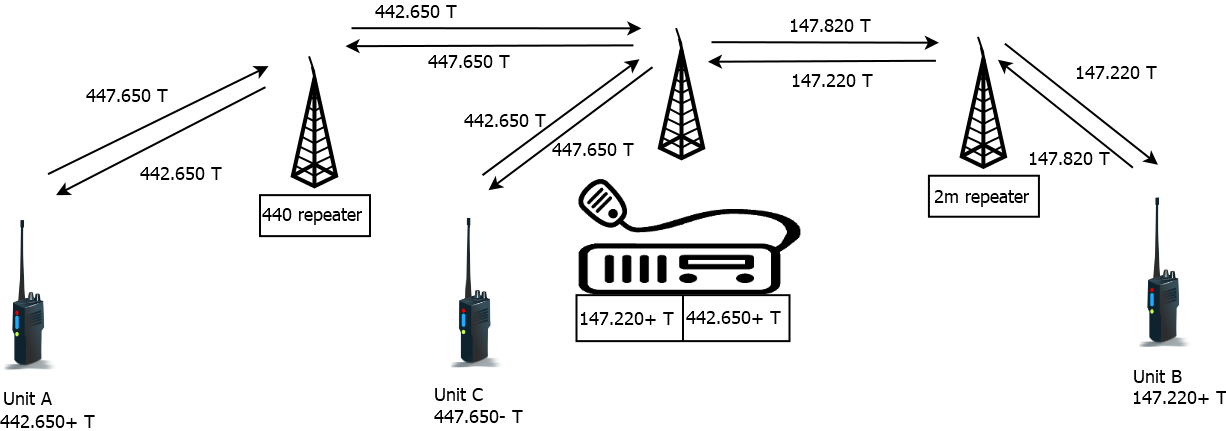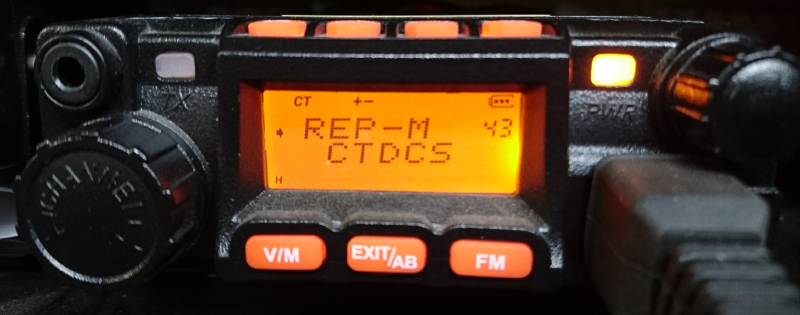Crossband Repeater
A crossband repeater is different from a regular repeater in two important ways:
| Regular Repeater | Crossband Repeater | |
|---|---|---|
| 1. | Uses the same band with a small offset between the tx and rx frequencies (600 kHz for VHF and 5 MHz for UHF) | Uses two frequencies on different bands (one on VHF and the other on UHF for example) |
| 2. | Always listens to the same frequency (the input of the repeater) and always transmits on the other (the output) | Re-transmits on one frequency whatever it hears on the other, whichever it hears first. |
Many higher end dualband radios are capable of doing cross-band repeat (Icom's ID-5100 or Kenwood's TM-D710G are two examples). Below are different uses for a crossband repeater.
Adhoc Repeater
Simplest
The simplest way to use a crossband repeater only works for two handhelds:

- Here, each handheld uses a different band.
- The problem is that you can't add more handhelds (unless they can already hear the others in simplex).
For more people
If you have more than two people, everyone will have to agree to use the same “input” and “output” frequencies, but that requires more fancy dual band tx/rx:

- All handhelds are set to listen to 446.100 and transmit on 145.565 so that when Unit A transmits on 145.565,
- The crossband repeater hears the 145.565 signal and re-transmits it on 446.100
- Which Unit B hears, and vice versa.
In practice, it might be tricky to setup the handhelds to receive on one band and transmit on the other. With Baofeng radios, I found it was easier to have receiver A set to the Tx frequency and receiver B to the Rx frequency.
But also: look for a menu called something like RxMode. The four options I have on mine are:
CROSS BAND(uses two handhelds to create a cross band repeater)DUAL RX RESPOND(the radio switches to whichever band it hears for the next transmit)MAIN ONLY(the radio only uses the selected band so you can't hear the second one)MAIN TX / DUAL RX(the radio only transmits on the selected band, but can hear both)
The last option is the right one to use for this setup
Repeater Extender
Simplest
This is a scheme I used to use at home with my base station in crossband mode: Tune one receiver to our local repeater, and the other to a simplex UHF frequency. Then use the handheld around the house and the yard with the “power” of my base station and antenna to get into the repeater.
- Unit A transmits and receives on 446.100 (with a tone).
- The crossband repeater hears 446.100 (with a tone squelch) and re-transmits it on 147.820 (the input of the repeater).
- The repeater hears 147.820 and repeaters it on 147.220 (its output)
- Unit B receives 147.220 and replies on 147.820, which
- The repeater re-transmits on 147.220
- The crossband repeater hears 147.220 and re-transmits it on 446.100.
All that is needed to “program” the crossband repeater is to tune it to the regular repeater frequency (with its proper offset and tone), and select a UHF simplex frequency for crossband repeating. I add a tone and tone squelch to the UHF frequency to limit interference being sent to the repeater from other operators who could join the UHF frequency not realizing it's in use.
The biggest flaw with this setup is that the radio doing the repeating is transmitting every time someone transmits, which means that the radio could transmit at close to 100% duty cycle, which it may or may not be designed to do. So it's best to use the lowest power setting and/or keep the use to a minimum.
One Way Variation
The following is a variation I use more often when I can hear the repeater with my handheld, but can't transmit to it because of the handheld's low power. In this configuration, the crossband repeater only transmit when I am transmitting, not when the others are transmitting, which is much much easier on the radio.
 The crossband repeater is set up with the input frequency of the repeater without the offset. The tone is set to the repeater tone, but the tone squelch is set to something else (I'll explain in a minute). So:
The crossband repeater is set up with the input frequency of the repeater without the offset. The tone is set to the repeater tone, but the tone squelch is set to something else (I'll explain in a minute). So:
- Unit A transmits on 446.100 and receives the repeater's output on 147.220.
- The crossband repeater hears 446.100 and re-transmits it on 147.820 (the input of the repeater).
- The repeater hears 147.820 and repeats it on 147.220 (its output)
- Unit B receives 147.220 and replies on 147.820
- Then, two things happen:
- The repeater hears the signal on 147.820 and re-transmits it on 147.220 but,
- The crossband repeater does NOT hear the signal from the repeater's output frequency because it's tuned to its input. It also doesn't hear the input of Unit B (in case it's close enough to), because it has a different tone squelch than the repeater's tone.
- So the crossband repeater stays silent.
- Unit A hears the output of the regular repeater, not the crossband repeater.
In this configuration, the crossband repeater only re-transmits Unit A, and not everyone else on the net, keeping the duty cycle low.
After much experimenting, I found that it's better for the second tone to be digital because a different analog tone sometimes interferes with the repeater's analog tone. Right now, this is how I setup my frequencies:
On the Crossband Radio
- Band A: 147.820 MHz with a TONE(T)/DTCS(R) tone (it transmits an analog tone and requires a digital tone to open the squelch)
- Band B: 446.100 MHz with a DTCS tone (it transmits a DTCS tone and requires one to open the squelch as well)
On the Handheld
- Band A: 446.100 MHz with a DTCS tone (for transmitting only)
- Band B: regular 147.220 MHz repeater frequency (for listening only)
Repeater Link
A crossband repeater can be used to link a VHF and UHF repeater simply by dialing both repeater frequencies (with offset and tones) on the crossband repeater.
Here again, high transmit duty cycle can be an issue.
Repeater Link Variation
Supposing a third handheld (Unit C) is close to the crossband repeater but can't hear either repeaters. Unit C can still communicate with Unit B by “impersonating” the UHF repeater: note the difference between Unit A and Unit C. In this configuration, Unit A and B can still communicate with each other, but Unit C can't reach Unit A.
To reach Unit A, Unit C would need to “impersonate” the VHF repeater and be setup as the “opposite” of Unit B.
KT-8900
It's pretty easy to setup a cross band repeater with two KT-8900 radios.

- The first step is to make an ethernet patch cord with this pin out:
| 1 (Data Input) | ↔ | empty |
| 2 (RPT CTRL) | ↔ | 5 (PTT) |
| 3 (MIC) | ↔ | 8 (AF OUT) |
| 4 (MIC GND) | ↔ | 4 (MIC GND) |
| 5 (PTT) | ↔ | 2 (RPT CTRL) |
| 6 (GND) | ↔ | 6 (GND) |
| 7 (+8VDC OUT) | ↔ | empty |
| 8 (AF OUT) | ↔ | 3 (MIC) |
- For my setup:
- I set the UHF radio to low power because it's either going to be used on a UHF simplex frequency when I'm around the house, or by VE7SCK, which is also really close. It's also the radio that'll be transmitting the most since it's listening to VE7RXZ (or whichever other repeater I want to crossband repeat).
- I set the VHF radio to high power because this radio would need to reach a repeater further away. It will also only transmit when I'm speaking on the UHF simplex frequency or when someone is using VE7SCK, which is less often.
- Once both radios are on their correct frequencies (one must be on UHF and the other on VHF), connect the cable to link them both.



